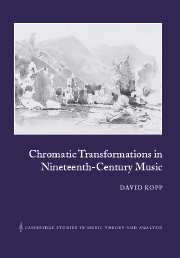Book contents
- Frontmatter
- Contents
- Foreword by Ian Bent
- Acknowledgements
- 1 Common-tone tonality
- 2 Three examples of functional chromatic mediant relations in Schubert
- 3 Key harmonic systems and notions of third relations from Rameau to Hauptmann
- 4 Hugo Riemann
- 5 Twentieth-century theory and chromatic third relations
- 6 Riemann's legacy and transformation theories
- 7 A chromatic transformation system
- 8 Chromatic mediant relations in musical contexts
- 9 Five analyses
- Bibliography
- Index
- Compositions cited
4 - Hugo Riemann
Published online by Cambridge University Press: 22 September 2009
- Frontmatter
- Contents
- Foreword by Ian Bent
- Acknowledgements
- 1 Common-tone tonality
- 2 Three examples of functional chromatic mediant relations in Schubert
- 3 Key harmonic systems and notions of third relations from Rameau to Hauptmann
- 4 Hugo Riemann
- 5 Twentieth-century theory and chromatic third relations
- 6 Riemann's legacy and transformation theories
- 7 A chromatic transformation system
- 8 Chromatic mediant relations in musical contexts
- 9 Five analyses
- Bibliography
- Index
- Compositions cited
Summary
THE EARLY THEORY
The theory of harmonic function for which Hugo Riemann is best known was not an early inspiration, but rather the culmination of a long and prodigious effort. Nor was it Riemann's last say on the nature of the tonal harmonic system. Riemann's theoretical career spanned over five decades and included a series of important works on harmony. Perhaps even more than Rameau, Riemann significantly developed and outright changed his ideas over the course of these publications. In the next chapter I will present a limited review of Riemann's works, spanning several decades from the early 1870s, when Riemann embarked on the development of a complex harmonic system which came to fruition in the late 1880s, through the introduction of the function concept in the early 1890s, up to the important new ideas of the late 1910s, which will be described later in chapter 6. As before, I will focus on two aspects of theory: first, Riemann's evolving conceptions of the harmonic system, and, second, his views of mediant relations and the way in which those views are able to be reflected within these changing terms.
Throughout his career, Riemann freely acknowledged the influence of other thinkers on his own ideas, particularly three immediate German predecessors, Arthur von Öttingen, Hermann von Helmholtz, and Moritz Hauptmann. He mentions his debt to them in his dissertation (1872), discusses their ideas in Die Natur der Harmonik (1882), and continues to do so in Vereinfachte Harmonielehre (1893).
- Type
- Chapter
- Information
- Chromatic Transformations in Nineteenth-Century Music , pp. 61 - 102Publisher: Cambridge University PressPrint publication year: 2002



